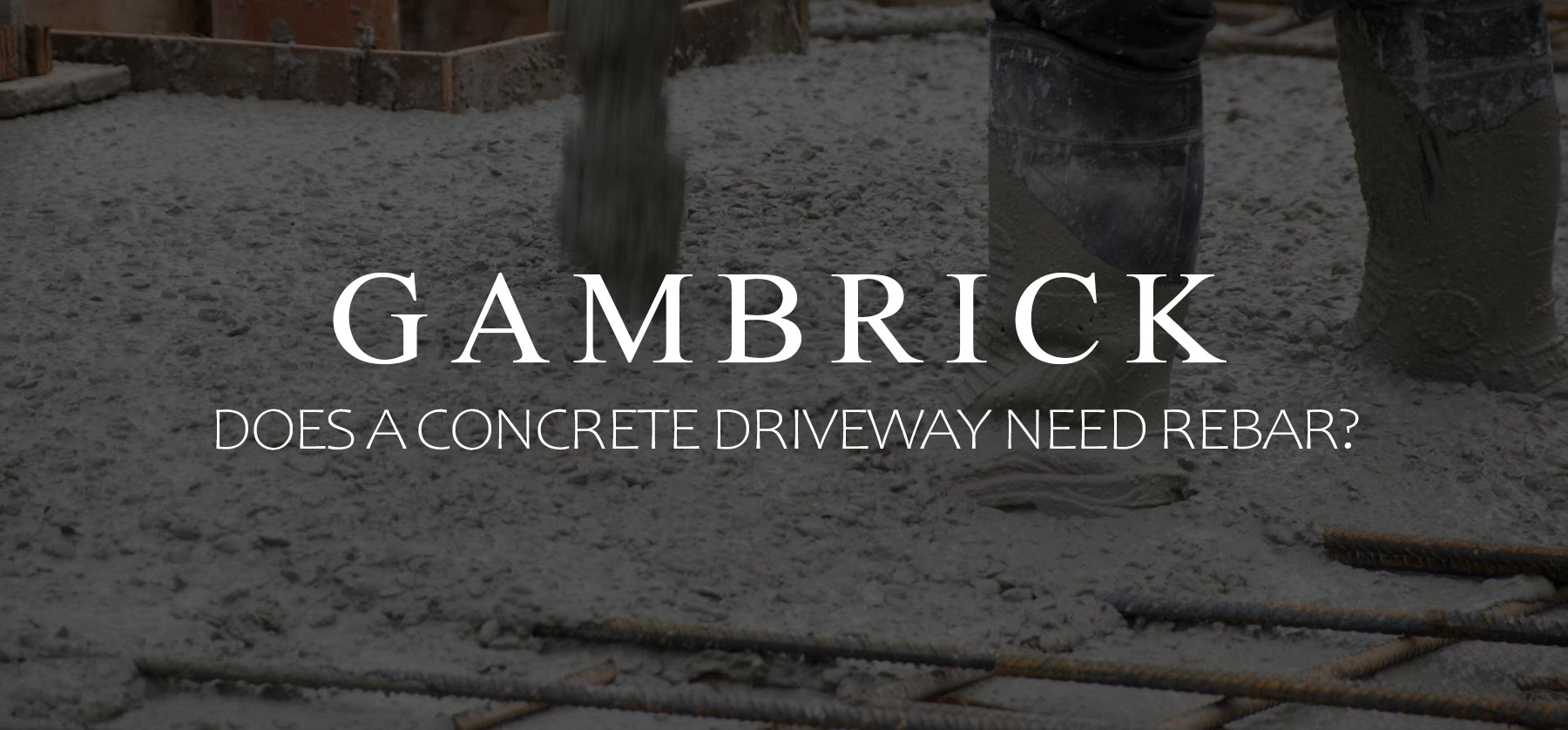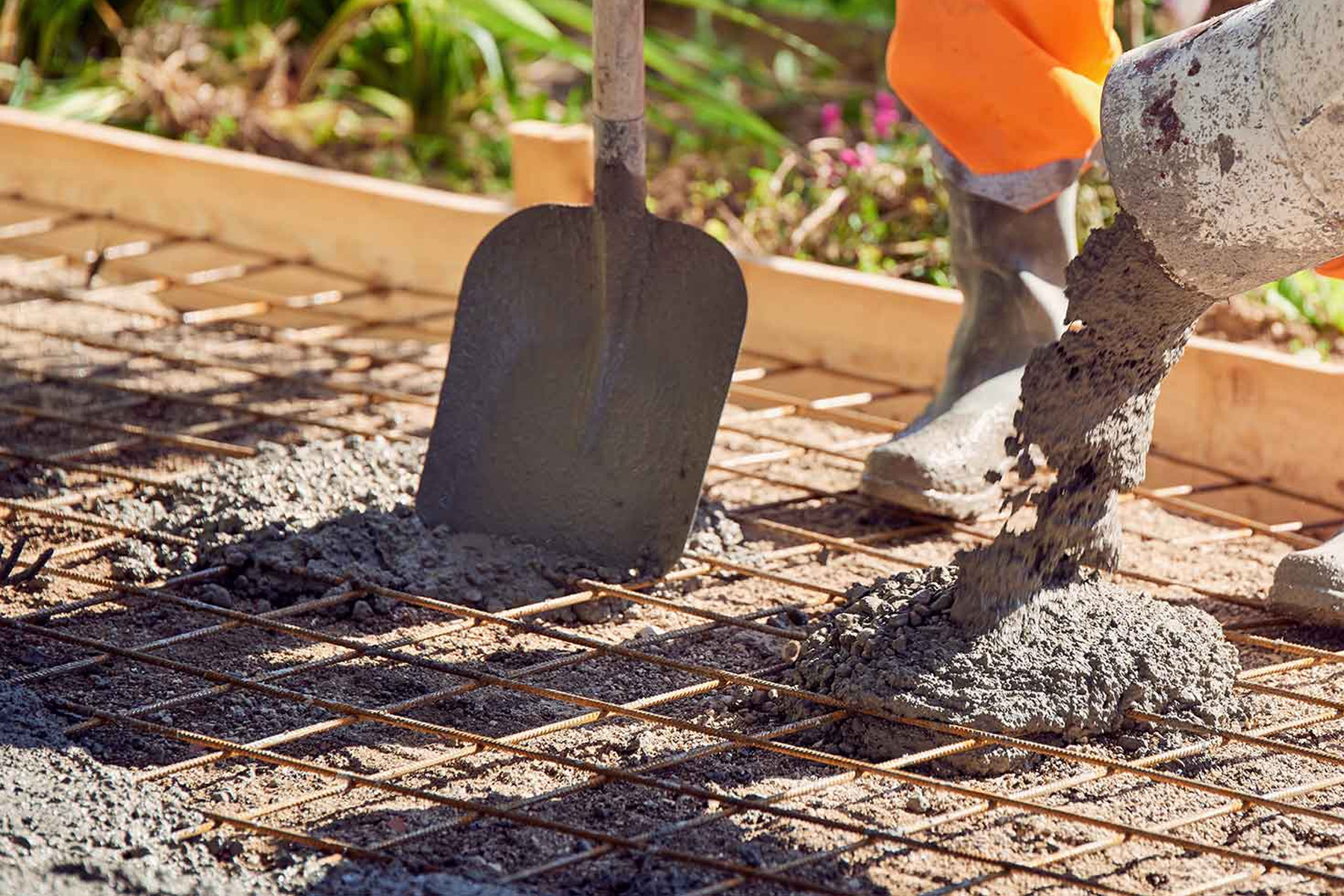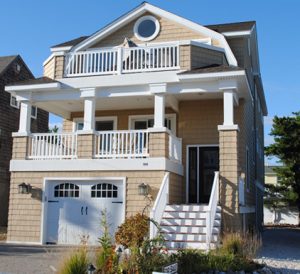
Does A Concrete Driveway Need Rebar?
A concrete driveway needs to be strong enough to support the cars and trucks that drive over it. But it also has to resist the forces of weather, contraction, expansion, snow, ice, sun, salt and water. If you want your driveway to last it should be built strong and durable. Concrete on it’s own has very high compressive strength. Meaning it can bear a lot of weight without cracking. But it has very low tensile strength. This is the resistance it has to breaking under tension or flexing. To increase a concrete driveway’s durability and crack resistance, rebar can be added. Rebar provides additional support to concrete structures. Including rebar inside a concrete driveway gives it considerably more strength than concrete alone.
Rebar isn’t necessary inside every concrete driveway. Many residential driveways are strong enough with just wire mesh. However, if you plan on driving heavier vehicles like trucks over it or live in an area that deals with snow and ice, I recommend using rebar.
As a general rule, I use rebar inside any concrete driveway that’s 5 inches thick or less.
Concrete needs reinforcement because it makes the concrete stronger and helps prevent cracks. This can save you money on repairs and keep your driveway looking like new for decades.
You should use rebar inside a concrete driveway to provide more strength, durability and longevity. Especially if it handles heavy loads or goes through the freeze thaw cycle.
In the following article, we’ll discuss how and when to use rebar inside a concrete driveway and the different types you can use.
What is Rebar?
Rebar is short for reinforcing bar. The bars are made of steel and generally have nubs around the sides where concrete can grab. Rebar comes in a variety of designs and sizes. Some even have special coatings that resist rusting.
Rebar has been used for over 150 years to reinforce concrete structures from the inside. Concrete slabs, like driveways, are prone to cracking. Rebar holds the slab together as pressure tries to push concrete apart. It does this by increasing the slabs tensile strength. Without some form of reinforcement inside the slab, concrete is easy to crack.
Rebar is steel and prone to rusting. But when rebar is inside a driveway it doesn’t rust because oxygen can’t get to it. If concrete breaks away or cracks in a way that exposes the rebar it can start to rust. This deteriorates the concrete. For this reason it’s very important to repair cracks right away so that they don’t effect the rebar.
Rebar is tied together with metal wire into a cage. The cage forms a skeleton for the concrete. The rebar skeleton sits in the middle of the slab. When rebar is placed on the ground before concrete is poured, it’s held high by metal legs called chairs. Chairs are very important because they set the height of the rebar. For example, if you’re pouring a 6 inch driveway with 1/2 inch rebar, you would set the chairs at 2 3/4 inches. This keeps the rebar in the center of the driveway.

When To Use Rebar In A Concrete Driveway
I use rebar in a concrete driveway when it’s at least 5 inches (12.7 cm) thick and must support heavy loads. I also use it when the driveway will go through a freeze thaw cycle or if the soil is bad.
- Thickness: The thicker the slab the more weight it’s designed to carry. This means the driveway will benefit from rebar. If it’s a small driveway designed for a single car, 4 inches thick and wire mesh may be enough.
- Weather: When water penetrates inside the concrete, freezes and then thaws, it creates a lot of pressure. This is called the freeze thaw cycle. Rebar helps resist this pressure.
- Soil: If the soil beneath your driveway is bad and may have sinkholes, rebar can help. It keeps the driveway strong even if areas are unsupported.
Rebar and other forms of reinforcement provide your driveway with additional strength, durability and longevity. It holds concrete together from the inside which helps prevent cracks from appearing on the surface.
If your driveway will only carry smaller vehicles or lighter equipment, doesn’t see a freeze thaw cycle and is built on sturdy ground, you may not need rebar. In these cases wire mesh may be enough.
I always include at least rebar and/or wire mesh in all of my driveways. Even if soil conditions are good and the driveway doesn’t see ice or heavy loads, there are still external factors to deal with like rain and sun.
The Benefits Of Rebar In A Concrete Driveway
Using rebar in a concrete driveway is more expensive than wire mesh, but it has a few big benefits.
- Longevity: Rebar can save you money on maintenance and repairs in the long run. This provides a good ROI when compared to the extra cost vs wire mesh. A new concrete driveway is an expensive investment, so it may make sense to spend the extra money making it as strong and durable as possible.
- Strength: Thicker concrete with rebar is much stronger than thinner concrete without. You may not plan on driving heavy vehicles on your driveway, but it may happen anyway. In this case you’ll want the extra strength.
- Durability: Rebar makes a concrete driveway more durable by increasing its tensile strength. This can help if the soil becomes unstable or you encounter bad weather.
When it comes to smaller slabs, wire mesh may be enough reinforcement. If you plan on using wire mesh inside your concrete driveway instead of rebar, spend extra time on the sub base. If the ground is undermined you’ll get driveway cracks.
Although rebar isn’t always necessary for small scale concrete driveways, I still recommend using some. You can use it along side wire mesh to strengthen weaker areas like the sides or joints. This is where concrete is more prone to crack.
Rebar gives you more strength than you need just in case something goes wrong with the weather, carrying loads, curing, the mix or soil. If for some reason the pour or site conditions aren’t always perfect, rebar can help carry the load.
Types Of Driveway Rebar
In addition to deciding whether or not your concrete driveway needs rebar, you’ll also have to choose a type.
Rebar comes in a few different forms which include:
- Standard Rebar: The typical rebar you’ll find in 99% of driveways is black in color and made from carbon steel. It is prone to rusting so it must be completely encased in concrete in order to work properly. Never use standard black rebar anywhere that’s exposed to the elements.
- Stainless Steel Rebar: This is the most expensive type of rebar because it’s made from stainless steel. Stainless steel doesn’t rust, so it’s safe to use in the elements. This can be an advantage if your driveway cracks, but cracks shouldn’t happen if you build the driveway correctly. It costs about 10x more than standard rebar so I wouldn’t recommend using it.
- Epoxy-Coated Rebar: Rebar is coated with a special expoxy to make it resistant to the elements. The epoxy coating is very delicate. If it rubs off the epoxy does nothing to protect the rebar inside. I don’t recommend paying the extra cost for this either.
- Galvanized Rebar: Galvanized rebar is about forty times more resistant to corrosion than standard rebar and a lot tougher than epoxy coated. It’s also abut 40% more expensive than epoxy. But I’m willing to pay the extra expense when I need a more resistant rebar. Epoxy is too delicate for me.
In general, standard black rebar is what I use in concrete driveways. However, in some rare cases I’ll use galvanized when the architect calls for it. I’ve tried epoxy but it’s a bit too delicate and stainless steel is way too expensive.
Using Driveway Rebar
Rebar is best in a concrete driveway that’s at least 5 inches thick. This is because rebar is thicker than galvanized mesh reinforcement and there needs to be at least 2 inches of concrete between the rebar and concrete’s surface.This is true of all surfaces including the top, sides and bottom of the slab. If concrete gets too close to the surface, it can cause cracks.
Rebar reinforcement should be laid in the center of the slab. To do this, masons hold up the rebar on special metal or plastic supports, called “chairs.”
It’s also possible to use bricks or other masonry materials for support, but this can create weak spots in the slab. I recommend using chairs to hold up the rebar.
Rebar grids are built by laying pieces of bar horizontally and vertically on top of each other to form a grid pattern. The rebar are tied together at each intersection with metal wire ties.
The edges of the grid should be kept at equal distances from all sides of the slab including the top and bottom. Uniformity is very important. If rebar isn’t used evenly, you could end up with weak spot in the driveway.
What Happens If You Don’t Use Rebar In A Concrete Driveway?
If you don’t use rebar in a concrete driveway, it will be weaker, less durable, and more prone to cracks.
- Excessive tension forces can crack the concrete. A major cause of this is soil problems. If you have an undermined area beneath the slab, usually caused by water, the concrete can crack. This can be prevented by using rebar.
- Soil is a big cause of concrete driveway cracks. Spend a lot of time creating a strong and stable sub base. But water or settling beneath the slab can cause undermined areas. This is especially problematic in many parts of Florida that are prone to sinkholes. Rebar holds the slab together in areas that are not properly supported.
- Existing cracks will expand and spread easier without rebar to hold the concrete together.
- Spreading can happen if the slab cracks because rebar isn’t there to hold it together.
- Weather is a major issue with concrete. Especially the freeze thaw cycle. If this is a problem where you live, add another inch of concrete and use rebar.
- Weight can cause cracks in the slab. Rebar usually means thicker concrete. Together they create a much stronger driveway that can resist heavy loads.
If your concrete pour is 4 inches (10.16 cm) or less, properly supported by a strong sub base, and doesn’t carry extremely heavy loads, it’ probably OK to use just wire mesh. But an extra inch of concrete and some rebar go a long way to preventing future damage.
Rebar Vs Wire Mesh
An alternative reinforcement to rebar for a concrete driveway welded wire mesh.
The mesh is made of galvanized wire that’s welded together to form a grid.The wire mesh panels are placed in the middle of a concrete slab just like rebar. They work in the same way as rebar but aren’t as strong. However they’re much thinner which makes them better for thin slabs off around 4 inches.
Wire mesh is much cheaper than rebar. The grids are pre-made at a factory so there much less labor involved. And the material is also much cheaper. If you’re on a budget, wire mesh is definitely the way to go.
Wire mesh grids come in different lengths, shapes, and thicknesses. This makes it a very versatile material that’s easy to work with. I but it in large 50′ rolls that are 4 foot wide. Simply roll it out along the driveway and cut it to length.
However, if you have the extra money, a 5 inch driveway with 3/8 inch thick rebar is much stronger and more durable.
A good compromise is using 5 inches of concrete with wire mesh and 3/8 inch rebar along the edges. Strengthening the edges is a good idea because this is where most cracks occur.
Rebar is much stronger and more durable but costs more and requires a thicker slab. Wire mesh is cheaper and designed for thinner slabs that won’t be under extremely heavy loads. But I would only use wire mesh on very strong Earth. If there’s a chance the ground beneath your driveway could settle, use rebar.
How Far Apart Does Rebar Need To be In A Concrete Driveway?
Create a grid pattern with your rebar by placing rods no more than 12 inches apart both horizontally and vertically. I usually place my rebar around 6-8 inches apart for extra strength. It costs a little bit more but helps prevent cracks.
Use special metal supports called chairs to lift the rebar grid off the ground. The grid should sit in the middle of the concrete slab. Keep rebar at least 2 to 3 inches away from the sides, top and bottom of the concrete. If rebar is too close to the edges it could create cracks.
Keep in mind that rebar horizontal and vertical rebar rods lay on top of one another to form the grid. This means 2x 3/8 inch rebar makes 3/4 inch of steel. To keep the rebar at least 2 inches from all sides you need at least 4 3/4 inches of concrete. Most masons just round up to 5 inches.
Do You Need Rebar For A 4 Inch Driveway Slab?
A 4 inch concrete driveway slab is too thin for rebar. For a slab this thin you would use wire mesh instead.
Rebar needs to be kept at least 2 to 3 inches from the slabs surface on the top, bottom and all sides. This means all you can fit is wire mesh. And even that is pushing the 2 inch minimum. When rebar gets too close to the surface, it causes weak spots and potential cracks. I’ve seen entire driveways fail because rebar was too close to the surface. And this is true even when the slab is thick.
If you want to use rebar inside your concrete driveway, use at least 5 inches of concrete. This allows for either 3/8 inch or 1/2 inch of rebar. If you want a super strong driveway with 5/8 inch rebar, you’ll need around 6 inches of concrete.
Slabs thicker than 5 inches aren’t used much in residential work but are very common in commercial construction. However, in areas that are prone to weak soil or sinkholes, you may want the extra strength.
Summary: Is Old Concrete Stronger Than New Concrete?
A concrete driveway needs to be strong enough to support the cars and trucks that drive over it. But it also has to resist the forces of weather, contraction, expansion, snow, ice, sun, salt and water. If you want your driveway to last it should be built strong and durable. Concrete on it’s own has very high compressive strength. Meaning it can bear a lot of weight without cracking. But it has very low tensile strength. This is the resistance it has to breaking under tension or flexing. To increase a concrete driveway’s durability and crack resistance, rebar can be added. Rebar are metal bars used to provide additional support to concrete structures. Including rebar inside a concrete driveway gives it considerably more strength than concrete alone.
Rebar isn’t necessary inside every concrete driveway. Many residential driveways are strong enough with just wire mesh. However, if you plan on driving heavier vehicles like trucks over it or live in an area that deals with snow and ice, I recommend using rebar instead. As a general rule, I use rebar inside any concrete driveway that’s 5 inches thick or more.
Reinforcing concrete with rebar or wire mesh not only makes the concrete stronger, but also helps prevent cracks. This can save you money on repairs and keep your driveway looking like new for decades.
You should use rebar inside a concrete driveway to provide more strength, durability and longevity. Especially if it handles heavy loads or goes through the freeze thaw cycle.
If you have any questions or comments about concrete driveways, email any time.

John Mazzuca | About | More Posts |
Custom Home Builder
John Mazzuca is a custom home designer and builder at Gambrick with over 25 years experience in the construction industry. John has designed, built and/or remodeled hundreds of homes, small buildings, and commercial projects. He writes about business, real estate, home building, and household electronics. His work has been featured in Fox Business, Better Homes & Garden, House Beautiful, and more.




















